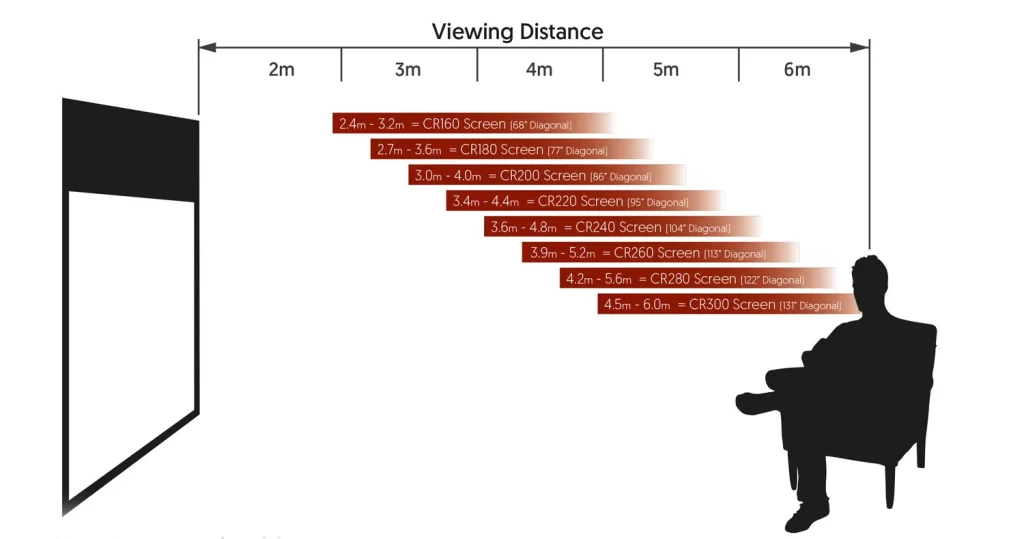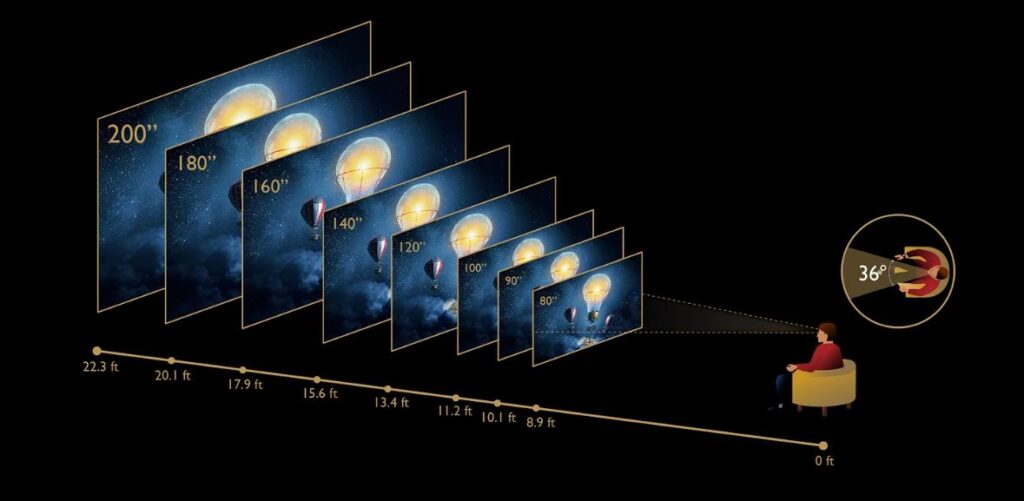
Introduction:
Are you excited to set up your new projector and create a cinematic experience right in your own home? The first question that may pop into your mind is, “How far should my projector be from the screen?” Finding the right distance is crucial for obtaining sharp, vibrant visuals and maximizing your viewing pleasure. In this comprehensive guide, we will explore the optimal projector-to-screen distance, taking into account factors such as screen size, projector type, and room dimensions. Get ready to transform your movie nights with the perfect projector placement!

How Far Projector Should Be from the Screen:
When it comes to projector placement, determining the ideal distance is essential. To achieve a balanced and immersive visual experience, follow these guidelines:
- Consider the screen size: The size of your screenplays a significant role in determining the projector’s distance. Larger screens typically require the projector to be placed farther away. As a general rule, for a 100-inch diagonal screen, the projector should be positioned around 10 to 12 feet away.
- Check the projector’s throw ratio: The throw ratio is an important specification to consider when selecting a projector. It indicates the distance between the projector and the screen required to produce a certain screen size. Different projectors have different throw ratios, so consult the manufacturer’s specifications or user manual for the optimal distance range.
- Calculate the projection distance: To calculate the projection distance, divide the screen width by the throw ratio. For example, if your screen width is 8 feet and the throw ratio is 1.5, the projection distance would be 5.33 feet (8 ÷ 1.5). This calculation helps you estimate the approximate distance needed for your projector.
- Consider the room size and seating arrangement: The dimensions of your room and the seating arrangement also affect the projector placement. In a smaller room, you may have limited space and need to position the projector closer to the screen. Conversely, in a larger room, you have more flexibility in choosing the projector distance.
- Avoid obstructions: Ensure there are no obstacles, such as furniture or lighting fixtures, blocking the projected image. Keep in mind that the projector should be positioned in a way that provides a clear line of sight to the screen.
- Test and adjust: Once you have determined the initial projector distance, it’s important to test and make adjustments if necessary. Project an image onto the screen and evaluate its sharpness, clarity, and brightness. If needed, fine-tune the distance until you achieve optimal image quality.
Factors Affecting Projector Placement:
1. Screen size:
The size of the screen you plan to use greatly influences how far the projector should be placed. Larger screens require the projector to be positioned farther away, while smaller screens demand a closer placement. Keep in mind that the screen size is measured diagonally from one corner to another.
2. Projector type:
Different projector types have varying throw ratios and lens characteristics. Short-throw projectors are designed to be placed closer to the screen, making them suitable for smaller rooms or spaces with limited throw distance. On the other hand, long-throw projectors are better suited for larger venues, as they can project images over longer distances.
3. Room dimensions:
The size and shape of your room impact the projector’s placement options. A smaller room may require a shorter throw distance, while a larger room allows for a greater distance between the projector and the screen. Consider the dimensions of your room when determining the optimal projector-to-screen distance.
4. Ambient light:
The presence of ambient light in your viewing environment affects image quality. Brighter rooms or spaces with significant natural light may require a higher projector brightness and closer placement to combat the light interference. Conversely, a dedicated home theater room with controlled lighting allows for more flexibility in projector placement.
5. Image quality preferences:
Your personal preferences regarding image size, sharpness, and brightness also play a role in determining the projector’s distance. Experiment with different distances to find the sweet spot that aligns with your desired viewing experience.
6. Ceiling or wall mount:
Decide whether you plan to mount the projector on the ceiling or place it on a table or shelf. Ceiling-mounted projectors typically have more flexibility in terms of placement, allowing for a greater distance from the screen. However, keep in mind that ceiling mounting requires additional installation considerations.
want to learn more about projectors?

Conclusion:
Determining the right distance between your projector and screen is crucial for achieving optimal image quality and an immersive viewing experience. Factors such as screen size, projector type, room dimensions, and personal preferences all come into play. By considering these factors and following the guidelines outlined in this guide, you can confidently set up your projector for an exceptional cinematic adventure. Experiment, test, and fine-tune the placement until you find the perfect sweet spot for your home theater. Now, sit back, relax, and enjoy the show
FAQs about Projector Placement:
1. How do I measure the screen size?
To measure the screen size, start from one corner of the screen and extend the measuring tape diagonally to the opposite corner. Make sure to include the entire visible area, including the frame if applicable.
2. Can I use a short-throw projector with a large screen?
Short-throw projectors are designed for smaller spaces, but they can still be used with larger screens. However, keep in mind that the image quality may not be as optimal compared to using a long-throw projector with a large screen.
3. Does the projector-to-screen distance affect image brightness?
Yes, the distance between the projector and screen can affect image brightness. Placing the projector farther away from the screen may result in a dimmer image, while a closer placement can enhance brightness.
4. What if my room has limited space for projector placement?
If you have limited space, consider using a short-throw projector or mounting the projector on a shelf or wall closer to the screen. This allows you to maximize the available space while maintaining an optimal viewing experience.
5. Can I use a projector in a room with windows and natural light?
Using a projector in a room with windows and natural light is possible, but it may require a brighter projector or additional measures to control ambient light. Consider using blackout curtains or blinds to minimize light interference.
6. How can I ensure a clear line of sight between the projector and screen?
Ensure there are no objects obstructing the projected image. Keep the projector’s line of sight unobstructed by positioning it at an appropriate height or using a mount that provides the desired angle.
Do you want to explore world? please visit